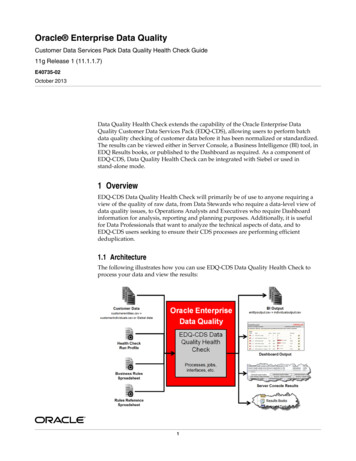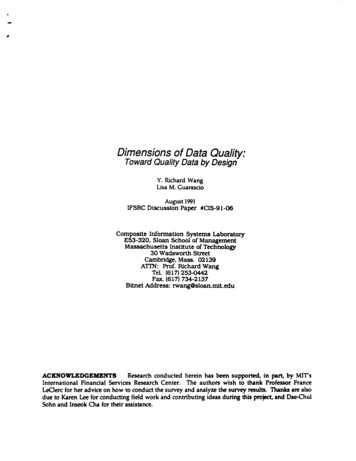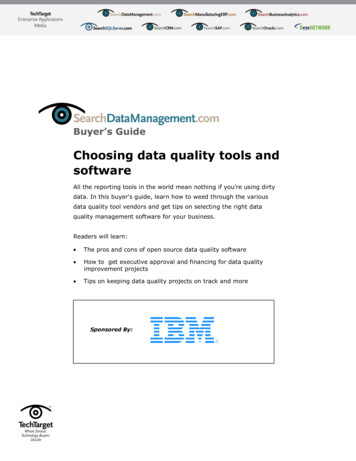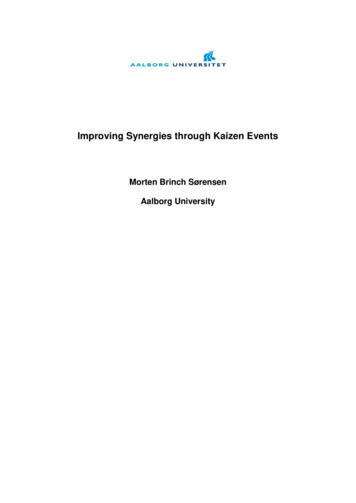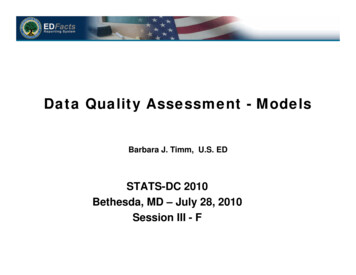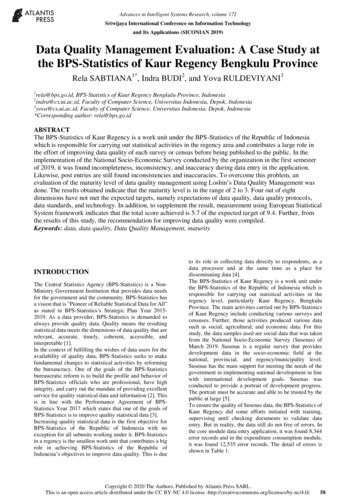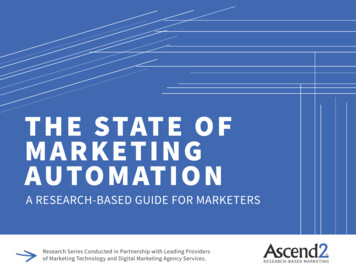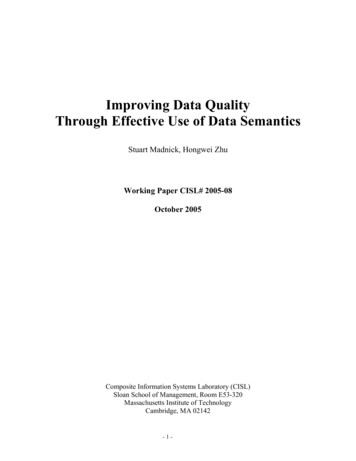
Transcription
Improving Data QualityThrough Effective Use of Data SemanticsStuart Madnick, Hongwei ZhuWorking Paper CISL# 2005-08October 2005Composite Information Systems Laboratory (CISL)Sloan School of Management, Room E53-320Massachusetts Institute of TechnologyCambridge, MA 02142-1-
Improving Data Quality Through Effective Use of Data SemanticsStuart Madnick*, Hongwei ZhuMIT Sloan School of Management, 30 Wadsworth Street, E53-320, Cambridge, MA 02142, USAAbstractData quality issues have taken on increasing importance in recent years. In our research, wehave discovered that many “data quality” problems are actually “data misinterpretation”problems – that is, problems caused by heterogeneous data semantics. In this paper, we firstidentify semantic heterogeneities that, when not resolved, often cause data quality problems. Wediscuss the especially challenging problem of aggregational ontological heterogeneity, whichconcerns how complex entities and their relationships are aggregated. Then we illustrate howCOntext INterchange (COIN) technology can be used to capture data semantics and reconcilesemantic heterogeneities, thereby improving data quality.Keywords: Data Quality, Data Semantics, Semantic Heterogeneity, Ontology, Context1. IntroductionData quality issues have taken on increasing importance in recent years. In our research, wehave discovered that many “data quality” problems are actually “data misinterpretation”problems – that is, problems with data semantics. To illustrate how complex this can become,consider Fig. 1. This data summarizes the P/E ratio for DaimlerChrysler obtained from fourdifferent financial information sources – all obtained on the same day within minutes of eachother. Note that the four sources gave radically different values for P/E ratio.SourceABCBloombergDBCMarketGuideP/E Ratio11.65.5719.197.46Fig. 1. P/E ratios for DaimlerChrysler.The obvious questions to ask are: “Which source is correct?” and “Why are the other sourceswrong – i.e., of bad data quality?” The possibly surprising answer is: they are all correct!The issue is, what do you really mean by “P/E ratio”1. The answer lies in the multipleinterpretations and uses of the term “P/E ratio” in financial circles. The earnings are for theentire year in some sources but in one source are only for the last quarter. Even when earningsare for a full year, are they:- the last 12 months?Corresponding author. Tel: 1 617 253 6671; fax: 1 617 253 3321.Email addresses: smadnick@mit.edu (S. Madnick), mrzhu@mit.edu (H. Zhu).1 Some of these sites even provide a glossary which gives a definition of such terms and they are very concise insaying something like “P/E ratio” is “the current stock price divided by the earnings”. As it turns out, this does notreally help us to explain the differences.*-2-
- the last calendar year?- the last fiscal year? or- the last three historical quarters and the estimated current quarter – a popular usage?Such information, which we call context, is often not explicitly captured in a form that can beused by the query answering system to reconcile semantic differences in data from differentsources. Serious consequences can result from not being aware of the differences in contexts anddata semantics. Consider a financial trader that used DBC to get P/E ratio information yesterdayand got 19.19. Today he used Bloomberg and got 5.57 (low P/E’s usually indicate good bargains)– thinking that something wonderful had happened he might decide to buy many shares ofDaimlerChrysler today. In fact, nothing had actually changed, except for changing the sourcethat he used. It would be natural for this trader (after possibly losing a significant amount ofmoney due to this decision) to feel that he had encountered a data quality problem.We would argue that what appeared to be a data quality problem is actually a datamisinterpretation problem. The data source did not have any “error,” the data that it providedwas exactly the data that it intended to provide – it just did not have the meaning that the receiverexpected. In other words, the issue is not what is right or wrong, it is about how data in onecontext can be used in a different context.Before going any further, it should be noted that if all sources and all receivers of data alwayshad the exact same meanings, this problem would not occur. This is a desirable goal – onefrequently sought through standardization efforts. But these standardizations are oftenunsuccessful for many reasons [18], e.g., there are legitimate needs for representing andinterpreting data in different ways to suit different purposes2. This creates the well knownproblem of semantic heterogeneities that exist pervasively in information systems. It is crucialthat we understand the kinds of heterogeneity and develop technologies to provide data that isconsistent with receiver preference, thereby improve the data quality at the receiver end. Such asolution can have significant impact as the estimated cost of information mishandling inbusinesses worldwide is tremendous [19].In the next section, we exemplify the semantic heterogeneities that, when not reconciled, cancause data quality problems. Then, we present the Context Interchange technology and showhow it can be used to capture data semantics and dynamically reconcile semantic differencesbetween the sources and the receivers. This technology supports the uniformity required by anyspecific receiver, at same time, it supports heterogeneity by preserving the autonomy of allsources and receivers. We conclude in the last section and point out directions for future research.2. Heterogeneous Data SemanticsThere have been a number of studies that identify and catalog various semanticheterogeneities [3,11,16,17]. A subset of the heterogeneities are related to data quality that weaddress in this paper and can be categorized into two main groups: (1) representationalheterogeneity and (2) ontological heterogeneity. Data semantics can sometimes change over time;therefore, representational and ontological semantics of a source or a receiver can evolve,resulting in temporal semantic heterogeneities. These categories are summarized in Fig. 2 andexplained next.A full discussion of all the difficulties with standardization is beyond the scope of this paper. It is worth notingthat the “Treaty of the Meter” committing the U.S. government to go metric was initially signed in 1875.2-3-
Representational OntologicalTemporalSnapshot exampleTemporal exampleRepresentationalCurrency:EUR in source v.USD in receiverCurrency:DEM until 12/31/98EUR since 1/1/99OntologicalProfit:Net excl. tax in source v.Gross incl. tax in receiverProfit:Net until 1999Gross since 2000Fig. 2. Data quality related semantic heterogeneities.Representational heterogeneity – The same concept can have different representations indifferent sources and receivers. For example, the day of March 4, 2005 can be represented as03/04/05, 05-03-04, etc; packaging dimensions can be expressed in metric units or in Englishunits; price data can be quoted in different currencies and using different scale factors.Temporal Representational heterogeneity – The representation in a source or a receiver canalso change. For example, a price database in Turkey may list prices in millions of Turkish liras(TRL), but after the Turkish New Lira (TRY) was introduced on January 1, 2005, it may start tolist prices in unit of Turkish New Lira3.Ontological heterogeneity – The same term is often used to refer to similar but slightlydifferent concepts. Known and quantifiable relationships often exist amongst these concepts. Wehave already seen an example of this regarding the multiple interpretations of “P/E ratio” in Fig.1.Temporal Ontological heterogeneity – In addition, in the same source or receiver, the meaningof a term can shift over time, often due to changes of needs or requirements. For example, profitcan refer to gross profit that includes all taxes collected on behalf of government, or net profitthat excludes those taxes. Net profit can be calculated from gross profit by deducting the taxes,and vice versa. The “Profit” field in a database may refer to net profit at one time and refer togross profit at another, because of changes in reporting rules.Aggregational Ontological heterogeneity – Another variation can be that the profit of a firmmay include that from majority owned subsidiaries in one case, and excludes them in anothercase (possibly due to different reporting rules in different countries or for different purposes.)Aggregational ontological heterogeneity has to do with what is included/aggregated in themeaning of an entity or a relationship. A specific example of this situation, sometimes calledcorporate housekeeping, will be presented later.Representational and ontological data semantics is often embedded in the explicit data andthe implicit assumptions; semantic heterogeneities exist when the implicit assumptions in thesources do not match the implied expectations of the receivers. They must be reconciled toensure the correct interpretation of the data by the receivers. In the following, we will use severalexamples to illustrate the semantic heterogeneities and their effects on data quality.Example 1: Temporal Representational Semantics (Yahoo Historical Stock Prices)When the same company stock is traded at different stock exchanges around the world, theremay be small price differences between exchanges, creating arbitraging opportunities (i.e.,buying low in one place and selling high at another). Fig. 3 gives an example of how big theThe following fact may help explain why this could be case: 1 USD 1.39 million TRL; 1 TRY 1 million TRL;it would be cumbersome to list many 0’s if prices were listed in unit of TRL.3-4-
differences can be – on the left are IBM stock prices in Frankfurt, Germany, on the right are thatin New York, USA. We notice that the values between the two exchanges during the same timeperiod are huge (comparing the values in the brackets); in addition, there is an abrupt price dropin Frankfurt while the prices in New York are stable (comparing the values in the circles). This isquite unusual! Again, one may start to question about data quality in the sources, but in fact, thepeculiarities in the data are due to semantic mismatches – the implied currencies not only differbetween the two exchanges, but also changed in Frankfurt from Deutschmark (DEM) to Euro(EUR); the currency in New York has always been USD. This is an example of representationalheterogeneity that also evolves over time. Frankfurt, GermanyNew York, USAFig. 3. IBM stock prices at different exchanges (from Yahoo).Example 2: Aggregational Ontological Semantics (Corporate Householding)The rapidly changing business environment has witnessed widespread and rapid changes incorporate structure and corporate relationships. Regulations, deregulations, acquisitions,consolidations, mergers, spin-offs, strategic alliances, partnerships, joint ventures, new regionalheadquarters, new branches, bankruptcies, franchises all these make understanding corporaterelationships an intimidating job. Moreover, the same two corporation entities may relate to eachother very differently when marketing is concerned than when auditing is concerned. That is,interpreting corporate structure and corporate relationships depends on the task at hand. Tounderstand the challenges, let us consider some typical, simple, but important questions that anorganization, such as IBM or MIT, might have about their relationships:[MIT]: “How much did we buy from IBM this year?”[IBM]: “How much did we sell to MIT this year?”The first question frequently arises in the Procurement and Purchasing departments of manycompanies, as well as at more strategic levels. The second question frequently arises in theMarketing departments of many companies and is often related to Customer RelationshipManagement (CRM) efforts, also at more strategic levels. Logically, one might expect that theanswers to these two questions would be the same – but frequently they are not, furthermore oneoften gets multiple different answers even within each company.These types of questions are not limited to manufacturers of physical goods, a financialservices company, such as Merrill Lynch, might ask:[Merrill Lynch]: “How much have we loaned to IBM?”[IBM]: “How much do we owe Merrill Lynch?”-5-
On the surface, these questions may sound like both important and simple questions to be ableto answer. In reality, there are many reasons why they are difficult and have multiple differinganswers.At least three types of challenges must be overcome to answer questions such as the onesillustrated above: (a) representational semantic heterogeneity, (b) entity aggregationalontological heterogeneity, and (c) relationship aggregational ontological heterogeneity. The firsttwo concern what IBM or MIT is, and the third one concerns how IBM and MIT are related.These challenges provide a typology for understanding what is sometimes called the CorporateHouseholding, as illustrated in Fig. 4 and explained below.Name: MITName: Mass Inst of TechAddr: 77 Mass AveAddr: 77 Massachusetts(a) Representational SemanticsName: MITEmployees: 1200Name: Lincoln LabEmployees: 840(b) Entity Aggregational Ontological SemanticsMicroComputerMITIBMCompUSA(c) Relationship Aggregational Ontological SemanticsFig 4. Typology for Corporate Householding Challenges.(a) Representational Semantics. In general, there are rarely complete unambiguous universalidentifiers for either people or companies. Two names may refer to the same physical entityeven though they were not intended to create confusions in the beginning. For example, thenames “James Jones”, “J. Jones”, and “Jim Jones” might appear in different databases, butactually be referring to the same person. The same problems exist for companies. As shown inFig. 4(a), the names “MIT”, “Mass Inst of Tech”, “Massachusetts Institute of Technology”, andmany other variations might all be used to refer to the exact same entity. They are differentsimply because the users of these names choose to do so. Thus, we need to be able to identifythe same entity correctly and efficiently when naming confusion happens. This problem has alsobeen called Identical Entity Instance Identification [10]. That is, the same identical entity mightappear as multiple instances (i.e., different forms) – but it is still the same entity.(b) Entity Aggregational Ontological Semantics. Even after we have determined that “MIT”,“Mass Inst of Tech”, “Massachusetts Institute of Technology” all refer to the same entity, weneed to determine what exactly is that entity? That is, what other unique entities are to beincluded or aggregated into the intended definition of “MIT.” For example, the MIT Lincoln Lab,according to its home page, is “the Federally Funded Research and Development Center of theMassachusetts Institute of Technology.” It is located in Lexington and physically separated fromthe main campus of MIT (sometimes referred to as the “on-campus MIT”), which is in-6-
Cambridge. Lincoln Lab has a budget of about 500 million, which is about equal to the rest ofMIT.Problem arises when people ask questions such as “How many employees does MIT have?”or “How much was MIT’s budget last year?”. In the case illustrated in Fig. 4(b), should theLincoln Lab employees or budget be included in the “MIT” calculation and in which cases theyshould not be? Under some circumstances, the MIT Lincoln Lab number should be included,whereas under other circumstances they should not be. We refer to these differing circumstancesas different contexts. To know which case applies under each category of circumstances, wemust know the context. As noted earlier, we refer to this type of problem as EntityAggregational Ontological heterogeneity.(c) Relationship Aggregational Ontological Semantics. Furthermore, even after we haveresolved the aggregation of entities, we still need to determine the relationships between theentities. As illustrated in Fig. 4(c), the buying/selling relationships between MIT and IBM can bedirect or indirect through other channels. Consider our original question – for IBM: “How muchdid we sell to MIT this year?” The answer to question varies depending on the aggregation ofsales channels. For example, under some circumstances, only the direct sales from IBM to MITare included, whereas under other circumstances, sales through other channels (e.g., throughpartners, retailers, etc.) are also included.In summary, the answers to the questions can be dramatically different because of the multiplesituations that exist. Different answers do not signify that some answers are wrong; all answerscan be correct under their corresponding circumstances, i.e., in their own contexts. Example 3: Temporal Ontological Semantics (Code v. What Code Denotes)In everyday communications and in various information systems, it is very common that werefer to things using various codes, e.g., product codes of a company, subject numbers in auniversity catalog, and ticker symbols commonly used to refer to company stocks. Codes aresometimes reused in certain systems, thus the same code can denote different things at differenttimes. For example, subject number “6.891” at MIT has been used to denote “MultiprocessorSynchronization”, “Techniques in Artificial Intelligence”, “Computational EvolutionaryBiology”, and many other subjects in the past decade. As an another example, ticker symbol “C”used to be the symbol for Chrysler; after Chrysler merged with Daimler-Benz in 1997, themerged company chose to use “DCX”; on December 4, 1998, the symbol “C” was assigned toCitigroup, which was listed as “CCI” before this change. Example 4: Temporal Aggregational Ontological Semantics (Yugoslavia)To study the economic and environmental development of different parts of the world, oneoften needs longitudinal data from various sources. In the past 30 years, certain regions havegone through significant restructuring, e.g., one country breaking up into several countries. Suchdramatic changes can make it difficult to use data from multiple sources or even from a singlesource. As an example, suppose a Balkans specialist is interested in studying the CO2 emissionsin the region of former Yugoslavia during 1980-2000 and prefers to refer to the region (i.e. thegeographic area of the territory of former Yugoslavia) as Yugoslavia. Data sources like theCarbon Dioxide Information Analysis Center (CDIAC)4 at Oak Ridge National Laboratoryorganize data by country. Fig. 5 lists some sample data from CDIAC. Yugoslavia as a country,whose official name is Socialist Federal Republic of Yugoslavia in 1963-1991, was broken into4http://cdiac.esd.ornl.gov/home.html-7-
five independent countries in 1991: Slovenia, Croatia, Macedonia, Bosnia and Herzegovina, andFederal Republic of Yugoslavia (also called Yugoslavia for short in certain other sources).Suppose prior to the break-up the specialist had been using the following SQL query to obtaindata from the CDIAC source:Select CO2Emissions from CDIAC where Country “Yugoslavia”;Before the break-up, “Yugoslavia” in the receiver coincidentally referred to the same geographicarea as to what “Yugoslavia” in the source referred, therefore, the query worked correctly for thereceiver until 1991. After the break-up, the query stopped working because no country is named“Yugoslavia” (or had the source continued to use “Yugoslavia” for the Federal Republic ofYugoslavia, the query would return wrong data because “Yugoslavia” in the source and thereceiver refer to two different geographic areas). iaBosnia-Herzegovinia5Federal Republic of issions.3560424055336145872902128912202.Fig. 5. Sample CO2 emissions data from CDIAC.These examples demonstrate that poor data quality can result from representational andontological heterogeneities between the sources and the receivers. They also suggest that we canimprove data quality by resolving these heterogeneities. In simple cases, this can be donemanually by the receivers. But in most practical cases that involve a large number of sources anddata elements, a manual reconciliation will be difficult and error prone. In the next section, wewill introduce the Context Interchange technology and show how it is used to improve dataquality by automatically reconciling semantic differences between the sources and the receivers.3. Improving Data Quality with Context Interchange Technology3.1. Context Interchange OverviewCOntext INterchange (COIN) [7,9,10] is a knowledge-based mediation technology thatenables meaningful use of heterogeneous databases where there are semantic differences. Withthe COIN technology, a user (i.e., information receiver) is relieved from keeping track of varioussource contexts and can use the sources as if they were in the user context. Semantic differencesare identified and reconciled by the mediation service of COIN. The overall COIN systemincludes not only the mediation infrastructure and services, but also a wrapping technology andmiddleware services for accessing the source information and facilitating the integration of themediated results into end-user applications (see Fig. 6). The wrappers are physical and logicalgateways providing a uniform access to the disparate sources over the network [5].Correct spelling is “Herzegovina”, which is an error; we do not address this kind of data quality problem in thispaper.5-8-
The set of Context Mediation Services comprises a Context Mediator, a Query Optimizer, anda Query Executioner. The Context Mediator is in charge of the identification and resolution ofpotential semantic differences induced by a query. This automatic detection and reconciliationof differences present in different information sources is made possible by accessing theknowledge of the underlying application domain, as well as informational content and implicitassumptions associated with the receivers and sources. These bodies of declarative knowledgeare represented in the form of a shared ontology, a set of elevation axioms, and a set of contextdefinitions, which we explain below.CONTEXT MEDIATION SERVICESSharedOntologyConversionLibraryLocal StoreUSERS andLengthAPPLICATIONSMeters /FeetDomainQuery iomsMetersSemi-structuredData Sources(e.g., XML)DBMSFig. 6. The architecture of the context interchange system.The input to the mediator is a user query assuming that all sources were in the user context.The result of the mediation is a mediated query that includes the instructions on how to reconcilethe semantic differences in different contexts involved in the user query. To retrieve the datafrom the disparate information sources, the mediated query is then transformed into a queryexecution plan, which is optimized, taking into account the topology of the network of sourcesand their capabilities. The plan is then executed to retrieve the data from the various sources.For the mediator to identity and reconcile semantic difference, necessary knowledge aboutdata semantics needs to be formally represented. For purposes of knowledge representation,COIN adopts an object-oriented logic data model, based on the formal theory of F-Logic [13], afirst order logic with syntactic sugar to support object-orientation (e.g., inheritance,polymorphism, etc.). Loosely speaking, the COIN data model has three elements, for which wegive a brief overview below and provide further explanations in the next sub-section: The Shared Ontology is a collection of concepts, also called rich types or semantic types,that define the domain of discourse (e.g., “Length”); Elevation Axioms for each source identify the semantic objects (instances of semantictypes) corresponding to source data elements, define integrity constraints, and specifygeneral properties of the sources;-9-
Context Descriptions annotate the different interpretations of the semantic objects in thedifferent sources or from a receiver's point of view (e.g., “Length” might be expressed in“Feet” or “Meters”).Finally, there is a conversion library which provides conversion functions for resolvingpotential semantic differences. The conversion functions can be defined declaratively or can useexternal services or external procedures. The relevant conversion functions are gathered andcomposed during mediation to resolve the differences. No global or exhaustive pair-wisedefinition of the conflict resolution procedures is needed. The mediator is implemented usingabductive constraint logic programming (ACLP) [12], which not only rewrites queries toreconcile semantic differences, but also performs semantic query optimization.3.2. Representing Heterogeneous Semantics using Ontology and ContextsTo a certain extent, ontology modeling and entity-relationship modeling [2,4] share the sameobjective of providing a formal way of representing things in the real world. An ontology usuallyconsists of a set of terms corresponding to a set of predefined concepts (similar to entities),relationships between concepts, and certain constraints. There are two types of binaryrelationships between concepts: is a, and attribute. The is a relationship indicates that a conceptis more specific (or conversely, more general) than another (e.g., the concept of net profit is morespecific than the concept of profit); the attribute relationship simply indicates that a concept is anattribute of another (e.g., the company concept is the profit of attribute of the profit concept).A high level concept can have various specializations. As shown in Fig. 7(a) below, profit canhave specializations such as gross profit and net profit, each can be further specialized to usevarious currencies, which can be further specialized to use different scale factors (e.g., inthousands or millions). Since the purpose of ontology is to share knowledge, it is tempting tofully describe these specializations in the ontology so that there will be no ambiguity in thesemantics of the concepts. However, the ontology of this approach is difficult to develop because(1) the ontology often consists of a large number of concepts, and (2) it requires various partiesengaged in knowledge sharing to agree on the precise definitions of each concept in the ontology.The COIN ontology departs from the above approach, as shown in Fig.7(b). It only requiresthe parties to agree on a small set of general concepts. Detailed definitions (i.e., specializations)of the general concepts are captured outside the ontology as localized context descriptions. Thecontext descriptions usually correspond to the implicit (and sometimes evolving) assumptionsmade by the data sources and receivers. To facilitate context description, the COIN ontologyincludes a special kind of attribute, called the modifier. Contexts are described by assigningvalues to modifiers.These two different approaches are illustrated in Fig. 7 using the company profit example.- 10 -
ProfitNet ProfitprofitOfcompanybasiccurrencykindGross ProfitscaleFactorProfitIn USD In EURIn USD profitOfcompanyIn EURLegendIn 1’s In 1M’s In 1’s (a) a fully specified ontology of profitIn 1M’stConcept/Semantic typeaAttributeis amModifier(b) a COIN ontology of profitFig 7. Fully specified ontology v. COIN ontology.The fully specified ontology in Fig. 7(a) contains all possible variations/specializations of theconcept profit, organized in a multi-level and multi-branch hierarchy. Each leaf node represents amost specific profit concept. For example, the leftmost node at the bottom represents a profitconcept that is a “net profit in 1’s of USD”. In contrast, the COIN ontology contains onlyconcepts in higher levels (e.g, profit), further refinements of these concepts do not appear in theontology; rather, they are specified outside the ontology and are described using modifiers (e.g.,if in a context, the profit data is “net profit in 1’s USD”, the context can be described byassigning appropriate values to the modifiers, i.e., kind “net”, scaleFactor “1”, andcurrency “USD”).Compared with the fully specified approach, the COIN approach has several advantages. First,a COIN ontology is usually much simpler, thus easier to manage. Second, it facilitates consensusdevelopment, because it is relatively easier to agree on a small set of high level concepts than toagree on every piece of detail of a large set of fine-grained concepts. And more importantly, aCOIN ontology is much more adaptable to changes. For example, when a new concept “netprofit in billions of South Korean Won” is needed, the fully specified ontology needs to beupdated with insertions of new nodes. The update requires the approval of all parties who agreedon the initial ontology. In contrast, the COIN approach can accommodate this new concept byadding new context descriptions without changing the ontology.Another important distinction is in the provision of conversions for reconciling semanticdifferences. Other approaches tend to provide pair-wise conversions between the data elementsthat correspond to the leaf nodes in the fully-specified ontology, e.g., a conversion between thedata of “net profit in 1’s of USD” and the data of “gross profit in millions of EUR”. We call suchconversions composite conversions. In the COIN approach, conversions are provided for eachmodifier; such conversions are called component conversions. All pair-wise compositeconversions are automatically composed by the mediator using the component conversions. Inthe example illustrated in Fig.7, with three component conversions (i.e., one for each modifier),the COIN mediator can compose all composite conversions as needed between
Keywords: Data Quality, Data Semantics, Semantic Heterogeneity, Ontology, Context 1. Introduction Data quality issues have taken on increasing importance in recent years. In our research, we have discovered that many "data quality" problems are actually "data misinterpretation" problems - that is, problems with data semantics.

